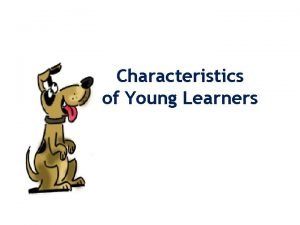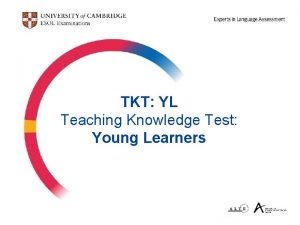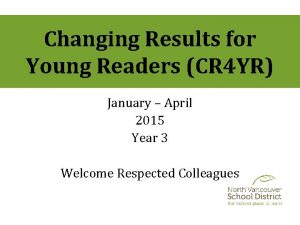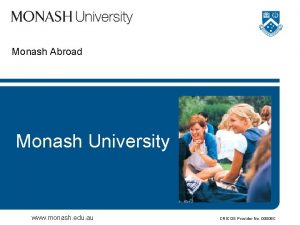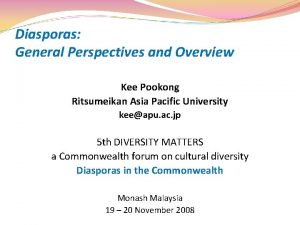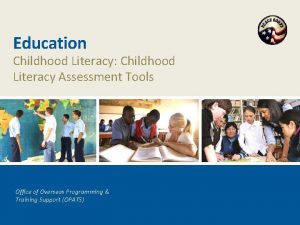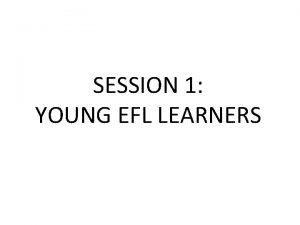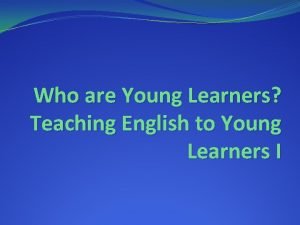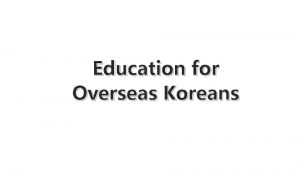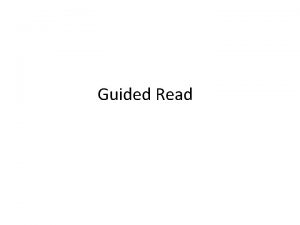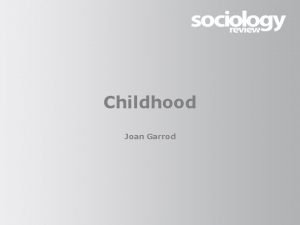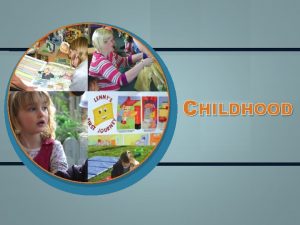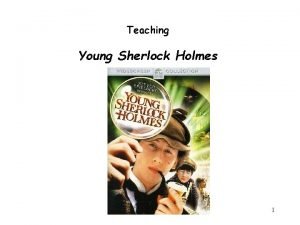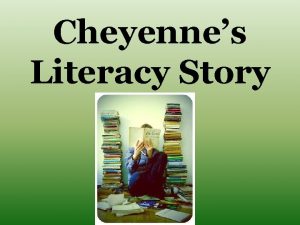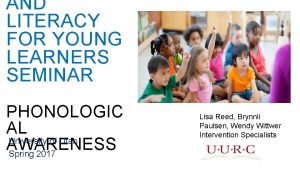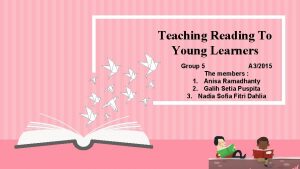Childhood Literacy Teaching Young Learners Office of Overseas














- Slides: 14

Childhood Literacy Teaching Young Learners Office of Overseas Programming & Training Support (OPATS)

Session Objectives § By the end of the session, participants will explain how child development and the learning triangle influence designing learning encounters with young learners. § After the introduction and discussion of child development, participants will describe the four areas of child development.

K-W-L § What do I already know about teaching young learners? § What do I want to know about teaching young learners? § What have I learned about teaching young learners?

Four Domains of Child Development § Cognitive Development § Language Development § Physical Development § Social-Emotional Development

Cognitive Development: § Thinking § Information processing § Problem-solving § Remembering § Decision making § Understanding concepts § Overall intelligence

Language Skills Development: § Includes both receptive language (understanding spoken language) and expressive language (sounds, words, phrases) § Babies learn language rules, vocabulary, and the nuances of their mother language before they can speak it (as long as they are being spoken to)

Motor Skills Development: § Gross (large) motor skills – Arms, legs, and big muscles § Fine motor skills – Hands, fingers, toes, and feet § The brain is responsible for controlling all of these movements

Social and Emotional Development: § Critical to all other areas of development Includes: § Ability to give and accept love § Confidence § Ability to show empathy § Curiosity § Ability to relate well to others

Characteristics of primary school learners Age 5 -6 General Characteristics • • • Physical Development • • • Literacy Reading & Writing • Mathematical Understanding & Development • • Sciences Understanding & Development • Social- Emotional Development • • Age 7 -8 Likes routine and repetition • Enjoys learning with adult guidance • Learns best through structured play • Continuing gross and fine motor control Begins to use writing utensils Draws and writes • Begins to understand how print works Oral language translates to reading and writing skills Beginning number sense Enjoys simple operations Age 9 -10 Attention span increases • Enjoys learning both with guidance • and independently Likes group learning • Able to combine motor skills to engage in more complex physical activities like sports, bike riding Penmanship improves • • • Beginning readers Recognition of dimensions of language: sounds, patterns, and meaning • • Mastery of number sense, simple math operations Sees patterns • • • Scientific discovery influenced by straddling make-believe and reality • • • Beginning awareness of own and • others’ emotions • Looks towards adults for affirmation Uses love of structure to learn about the world and science Likes facts related to the sciences • Enjoys making friends Increased self-control • • Independent learners More abstract thinking and reasoning Utilizes creative and complex problem-solving strategies Proficiency and control with gross and fine motor skills Likes team games Physically able to write more and longer Reading for meaning Writing becomes more complex Uses reading for new content knowledge Understands more complex and abstract math concepts and more complex operations Uses math for real world apps Takes risks to gain new information Loves learning science facts Likes social activities Deepening friendships Enjoys cooperative group play

How Do Children (and Adults) Learn? Auditory Learners Use sight as a key tool for processing new information Visual Learners Process information best when information is presented orally Process information best by physically performing a task that incorporates the new information Kinesthetic (Hands. On) Learners

Gardner's Eight Intelligences Bodily-Kinesthetic Ability to express oneself with entire body. Children with this type of intelligence enjoy sports, dance, or creative drama. Musical-Rhythmic Ability to recognize musical patterns, appreciate and produce music. Children with this type of intelligence enjoy listening to or making music. Logical-Mathematical Ability to use logic and reason to solve problems. Children with this type of intelligence take pleasure in finding patterns and relationships. Verbal-Linguistic Ability to use language for expression. Children with this kind of intelligence learn best by talking, listening, reading, and writing. Interpersonal Ability to understand the feelings, behaviors, moods, and motives of others. Children with this type of intelligence make friends easily and use language to develop bonds and trust with others. Intrapersonal Ability to understand the inner self (also known as self-awareness). Children with this type of intelligence are skilled at organizing groups and understanding motives and desires of self. Visual-Spatial Ability to see the relationship of objects in space and develop mental images. Children who have this type of intelligence show a preference for pictures and images. Naturalistic Ability to classify objects in nature such as animals and plants. Children who have this type of intelligence learn best by using their senses to gather information.

Best practices & strategies in early primary grades § Student-centered: Builds on children’s background knowledge; uses children’s strengths to develop skills and master new concepts. § Structured and predictable: Uses or creates classroom routines; balances structured and unstructured work, group- and self-directed learning. § Optimizes developmentally appropriate practices: Active participation to master new information; encourages whole body learning and the use of tactile tools to aid in learning.

Best practices & strategies in early primary grades § Utilizes individually appropriate approaches: What we know about specific children is used to teach child as an individual. § Knows what is culturally important: Understands the values, expectations, and factors in children’s lives at home and in their communities to help provide meaningful, relevant, and respectful learning experiences.

Childhood Literacy Teaching Young Learners Office of Overseas Programming & Training Support (OPATS)
 How to teach grammar to young learners
How to teach grammar to young learners Teaching young learners english
Teaching young learners english Office of overseas schools
Office of overseas schools Involuntary attention definition
Involuntary attention definition Tkt young learners
Tkt young learners Changing results for young learners
Changing results for young learners Objectives of remedial teaching
Objectives of remedial teaching Early childhood and middle childhood
Early childhood and middle childhood Media literacy vs information literacy comparison
Media literacy vs information literacy comparison What is mil subject
What is mil subject Limitation of people in media
Limitation of people in media Cyber literacy and digital literacy
Cyber literacy and digital literacy Www.monash.edu.au
Www.monash.edu.au Lesson 1: europeans explore overseas
Lesson 1: europeans explore overseas Overseas chinese population
Overseas chinese population



